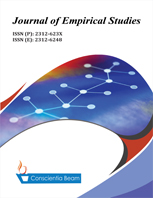Human Capital Development and Economic Growth in Nigeria: An Autoregressive Distributed Lag (ARDL) Approach
DOI:
https://doi.org/10.18488/journal.66.2020.71.41.51Abstract
This study investigated the relationship between human capital development and economic growth in Nigeria for the period of 1981-2017. Annual time series data from various issues of the Central Bank of Nigeria (CBN) statistical bulletin and World Development Indicator (WDI) were collected for the dependent variable - gross domestic product per capita (the proxy for economic growth) and the independent variables - human development index (HDI), number of under-five deaths (NUFD), gross fixed capital formation (GFCF), labour force participation (LABF), remittance (REM) and inflation rate (INF). The Augmented Dickey Fuller (ADF) and Dickey Fuller Generalized Least Squares (DF-GLS) detrending test were used to test for unit root while the Auto-Regressive Distributed Lag (ARDL) or the bound testing approach was employed in the study. The result showed that human capital development (HDI), labour force participation (LABF) and remittance (REM) had direct and significant long run impact on economic growth while the short-run estimated model revealed that the one-lagged value of gross domestic product (RGDP) and HDI had direct and significant impact on the dependent variable. The error correction term showed that in event of a disequilibrium, shock or perturbation, the system would restore itself to equilibrium at an adjustment speed of approximately 97.1%. To increase Nigeria’s human development index (HDI), it was recommended that remittances from international agencies should not only used judiciously by the government for the development of human capital. This would not only increase creativity, skill and productive capacities but also promote economic growth in Nigeria.

